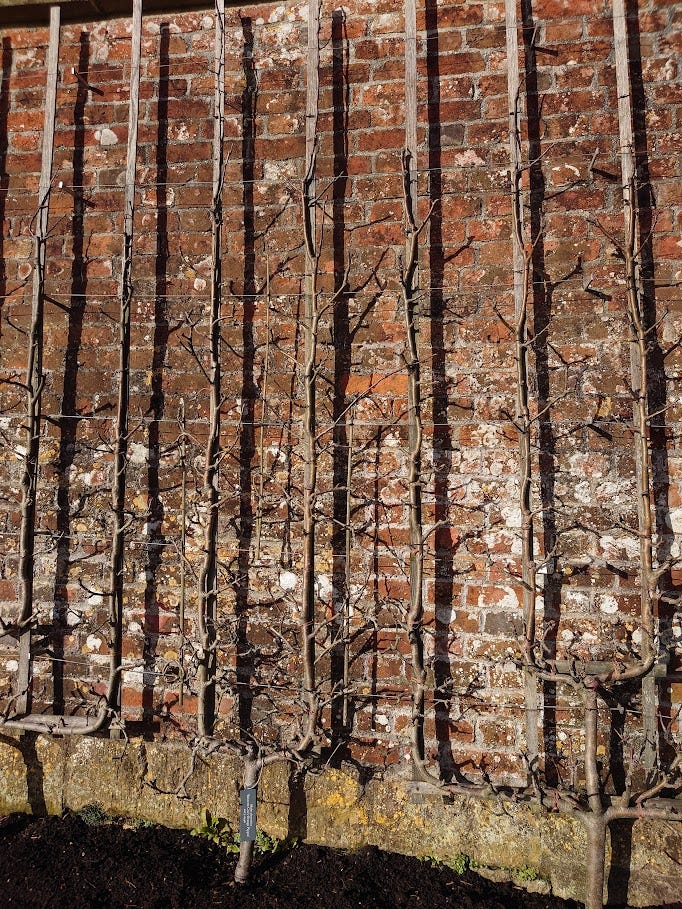Walls as climate tools
A look at the different types of walls, how they help in climate resilience and the role of walls in growing fruit
🌱 I'm Sally Morgan, an organic gardener and botanist who loves to experiment. Here you can read about matters relating to climate change, sustainability, organic gardening, growing veg and biodiversity, helping you to become a
climate savvy gardener 🌱☀️🌧️❄️🌡️
Resilience 6
Welcome to your monthly newsletter that delves into a particular topic (the full article is available to paid subscribers, but free subscribers can read a good section of it)
In this issue, I look at garden walls and how they could be valuable climate tools for the future.
I love walls and always dreamt of having a walled garden. That wish came true 20 years ago when we moved to Somerset. The house had a large walled garden that dated back 150 years or so. But there was a problem – it was completely overgrown with scrub, brambles, and nettles as it had been abandoned for decades. But before that, the space had been used as a kitchen garden. I put in some pigs and over the next couple of years they were rotated around the garden and slowly cleared the vegetation.
Extending to around 2/3 acre, it’s a large space. I divided it into quarters in typical kitchen garden style and used it as an experimental smallholding – one quarter was turned into an orchard of 25 trees, one quarter a traditional kitchen garden with dipping pond, one quarter for chickens and one quarter for pigs and cut flowers. A few years ago, the chickens and pigs were moved to another site and I set about turning their half of the garden into ornamental beds with a series of ponds and rills to slow the flow of water off our roofs in winter and act as a water harvesting system in summer. And, of course, central to all of this is climate resilience and boosting biodiversity.
A look at walls
Walls are incredibly useful garden features. They provide valuable vertical microclimates and growing spaces. South and west facing walls take up heat during the day, and release it at night, warming the air beside the wall. This is particularly useful in spring and autumn, when a boost of just a few degrees can help to protect against frost. In fact, it is estimated that the presence of a sunny wall is equivalent to moving 5 degrees latitude further south, so the microclimate in a walled garden in Hampshire or Surrey can be likened to the conditions in Bordeaux. This can be invaluable when warmer springs may tempt us into growing tender plants but there is the risk of a late frost.
Growing peaches in northern England
In 1561, the Swiss botanist Conrad Gessner noted the effects of radiated heat from walls on fruit trees and, as a result of his studies, ‘fruit walls’ appeared across northern Europe.
During the 1600s, the Little Ice Age was beginning to make its presence known, so walled gardens became more important. A thick wall could raise the temperature of the surrounding air by 10oC at night, allowing gardeners in more northern climes to grow a wide range of frost-sensitive fruits, such as peaches and apricots. And it was the need to maximise the growing space along walls that the ‘new’ pruning techniques to create cordons, espaliers and fans became popular.
Thanks to the clever use of walls, peach cultivation in Yorkshire become relatively commonplace in some of the kitchen gardens of the 18th and 19th centuries, despite the cool weather.
The walls also acted as windbreaks, shielding the blossoms and fruit from damage during unpredictable Yorkshire weather. Walls were often topped with copping stones that overhung by 15cm for added protection, while projecting metal brackets allowed glass, net or canvas to be hung vertically to protect plants.
On some of the wealthier estates, the walls were even fitted with internal flues and fireplaces to provide artificial heat. One such wall is at Tatton Park in Cheshire, with the chimney being disguised as an urn.
Combermere Abbey in Cheshire had a cavity wall, the south side being the inside wall of a lean-to greenhouse. There was a opening on this wall which allowed the gardeners to fill the cavity with straw and set it alight. The heat was absorbed by the bricks which helped to keep the greenhouse heated in winter.
These walled gardens were an example of how gardeners, working with engineers, were able to overcome the climatic challenges of the time.
Growing peaches for the Parisian market
By the mid-19th century Montreuil near Paris had hundreds of kilometres of walls enclosing small spaces (clos) for growing espalier fruit trees, such as peaches, apricots, apples and pears as well as standard fruit trees. These walls trapped heat and kept out the wind and if frost threatened, mats would be dropped down from the tops of the walls to protect the flowers. Consequently, as many as 17 million fruits were produced each year.
Many of these clos have been lost, but fortunately 8 hectares have been conserved and I would really love to visit! They are under the protection of Les Murs a Peches organisation and there is a interesting blog in English written by Sandra Lawrence here.
What are crinkle-crankie walls?








